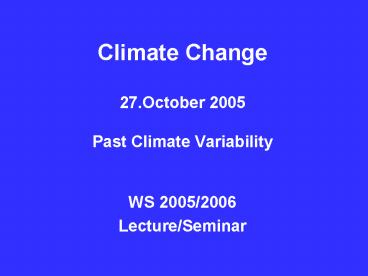Climate Change 27'October 2005 Past Climate Variability PowerPoint PPT Presentation
1 / 35
Title: Climate Change 27'October 2005 Past Climate Variability
1
Climate Change27.October 2005Past Climate
Variability
- WS 2005/2006
- Lecture/Seminar
2
- Following graphics either from the IPCC webpage
or free downloads from the www (e.g.
Wikipedia.org) - Presentations _at_
- http//biogeo.botanik.uni-greifswald.de
- Scroll members, Wilmking and teaching
3
Earth History
Precambrian ???? 540 Mio a
Paleozoic 540 250 Mio a
Proxies
Mesozoic 250 65 Mio a
Cenozoic Tertiary 65 1.8 Mio a Quaternary
1.8 Mio a - today
Measurements
4
Precambrian
beginning 540 Mio a
Evidence of two major glaciations
Faint Sun Paradox
Snowball Earth
5
Paleozoic Cambrian
N hemisphere (north of 30) ocean
Increased tectonic activity
CO2 high, up to 10x of today
Warm and wet globally
6
Paleozoic
Ord Ice formations 490 440 Mio a
Sil Dev no glaciation 440 350 Mio a
Car Per Ice ages 350 250 Mio a
Reason for this variation?
7
Carboniferous Ice age settings
8
Carboniferous Ice age settings
Continent near south pole
Maritime influence
Subfreezing T during most of year
Marine transgression continental flooding
Reduced seasonality
9
Carboniferous Ice age settings
Reason for this variation?
CC driven by land sea distribution
CC driven by tectonics
10
Mesozoic Climate Variability
Trias 250 205 Mio a Pangaea
Jurassic 205 145 Mio a Pangaea break up
Cretaceous 145 65 Mio a Continents as we know
them today
Generally warm and arid period No evidence of
glaciation Why?
11
Mesozoic Climate Variability
Trias 250 205 Mio a Pangaea
12
Pangaea characteristics
Lower sea levels
Reduced rate of tectonics
Extreme continental climate
Extreme dry
13
Pangaea break - up
Tethys seaway / transglobal equatorial seaway
formed
Heating of water at equator
Heat transport to low latitudes
14
Mesozoic Climate Variability
Pangaea No continent in pole position
Pangaea too dry
Transequatorial seaway heat redistribution
However Model problem
15
Model problem
Expected ice free high latitudes
Model T too low at high latitudes
Additional factor CO2
Ocean CO2 balance
16
Cenozoic Climate Variability
Tertiary (65 2 Mio a)
Quaternary (2 Mio a today)
Relatively warm in early Cenozoic
Early Eocene (55-50 Mio a) tropical conditions
10 15 further polewards
17
Cenozoic Climate Deterioration
Oligocene 25 Mio a Initiation of Antarctic Ice
Shield
Miocene 15 10 Mio a Growth of Antarctic Ice
shield
18
Cenozoic Climate Deterioration
Hypothesis 1
1) Transequatorial waterway blocked
2) Transpolar waterway opened through Drake
Passage reduced heat transfer
3) Growth of ice increase in albedo
4) Cooling
19
Cenozoic Climate Deterioration
20
Cenozoic Climate Deterioration
Hypothesis 2
1) Change in continental topography
2) Colorado / Tibetian Plateau uplift
3) Winter cooling of N-hemisphere
4) Ice formation
21
Cenozoic Climate Deterioration
Hypothesis 3
1) Orogenic uplift (as in Hyp 2)
2) Alpine / Himalayas (20-30 Mio a ago)
3) Increase in silicate weathering
4) Removes CO2 from atmosphere
22
Cenozoic Climate Deterioration
Hypothesis 3
5) Silicate CO2 Bicarbonate
6) Bicarbonate is soluble
7) Transport to oceans and deposition
Indirect effect by reduced greenhouse forcing
23
Cenozoic Climate Deterioration
Summary Combination of processes is necessary.
Land sea distribution, ocean heat transfer,
orography change and CO2 are all likely to cause
cooling of earth.
Right now, since 10 Mio a we are in an Ice age
(both poles ice capped) with glacial and
interglacial periods
24
Quaternary period
Pleistocene 1.8 Mio a 10Ta
Changes in former examples in Mio a
Drivers needed with cyclicity of 10-100Ta
e.g. Earth orbit variations around sun
25
Quaternary period
2 model approaches for glacial / interglacial
A) Ice volume changes are driven by orbital
forcing. Linear responses at 23/41 Ta, non-linear
at 100 Ta.
B) Ice volume changes happen, quasi period
fluctuations which then are modulated by orbital
forcing
26
Quaternary period
Important Orbital forcing alone is not enough.
Orbital forcing must interact with internal
climate variations
27
Quaternary period
C02 feedbacks C-cycle impacts on matching
time-scales
e.g. Oceans millenium time scale
However, existing ice core records do not allow
resolution of the phase relationship between CO2
and T
Cause effect still unclear
28
Quaternary period
Pleistocene Holocene boundary 10-11 Ta
Glacial maximum at 18 Ta
Holocene thermal maximum at 6 Ta
Rapid climate changes
29
Younger Dryas
30
ACR / YDC
31
ACR / YDC
Influx of freshwater from melting ice sheets
Shutdown or slowing of thermohaline circulation
Transition in a decade or so
Most pronounced in Europe
32
ACR / YDC
Europe Sweden saw displacement of forest by
tundra
Glaciation increased globally
Dust increased in atmosphere from deserts in Asia
Similar events in S hemisphere
33
ACR / YDC
End of Younger Dryas in 40-50 years
3 distinctive steps
7C warming in a few years
No human intereference
34
Overview I
- 20. Oct. Overview The Climate System
- 27. Oct. Past climate variability
- 3. Nov. LIA, MWP and the last 100 yrs.
- 10. Nov. Teleconnections (ENSO, NAO)
- 17. Nov. Arctic Climate Impact Assessment (ACIA)
2 SPres - 24. Nov. cancelled
- 1. Dec. cancelled
35
Overview II
- 8. Dec. Case study Boreal Zone
- 15. Dec. Case study Mid-latitudes
- 22. Dec. Case study Subtropics
- 5. Jan. Case study Tropics
- 12. Jan. Modelling and scenarios
- 19. Jan. Recent catastropies Hurricanes, Floods,
Droughts Climate is changing? - 26. Jan. Humans do not have an impact The
climate critics

